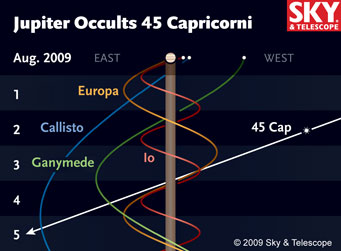This might just be the busiest time in living memory for people who love to observe Jupiter. First the plane of its moons pointed edge-on to Earth, allowing remarkable "mutual events" when the moons eclipse and occult each other.
Then, on July 19th, Australian amateur astronomer Anthony Wesley discovered that a comet or asteroid had struck the giant planet, leaving a dark marking that's still clearly visible. This is just the second time in the 400-year history of telescopic observing that such an event has been clearly documented.
And on the night of August 3-4, Jupiter will cover a 6th-magnitude star — a once-in-a-lifetime occurrence for most locations on Earth. The event occurs roughly from 22:53 Universal Time on August 3rd to 1:00 UT August 4th, varying slightly depending on your location. It happens at prime time for stargazers in Europe and Africa, and is also readily visible in the Middle East and Brazil.

Tony Flanders
In North America, the occultation can only be seen from New England and the Maritime Provinces — and barely so. In those locations, Jupiter will rise while it's hiding 45 Cap, and will still be extremely low in the sky when the star reappears.
But by amazing good luck, 45 Cap will be masquerading as a fifth moon during a particularly eventful period for Jupiter's Galilean moons. So weather permitting, every telescope owner on Earth will have a chance to see many fascinating events during the days before and after the occultation.
All of these events should be visible through small telescopes if the atmosphere is very steady, but extra aperture and high magnification will improve the views greatly. Try our Javascript utility or our PDF table for details of the moons' interactions with Jupiter. And download a PDF article from the July 2009 issue of Sky & Telescope to see the details of the "mutual events" between the moons.
Aug. 1-2, 10:19 p.m. to 1:48 a.m. PDT, 1:19 to 4:48 a.m. EDT: The first sequence is visible across the Americas. It starts with just three moons visible (not counting 45 Cap), because Ganymede is behind Jupiter. During this period Europa and its shadow pass over Jupiter, Ganymede reappears, and Io disappers.
Aug. 2-3, 9:49 p.m. to 12:25 a.m. PDT, 12:49 to 3:25 a.m. EDT: Again visible across the Americas, a normal transit of Io and its shadow across Jupiter — fairly common but spectacular nonetheless.
Aug. 2, 15:55 to 16:32 UT: Best in eastern Asia and Australia. Io casts its shadow on Europa from 15:55 to 16:02 UT, dimming it 50%. Then Io passes in front of Europa from 16:26 to 16:36 UT, blocking 74% of its surface. Meanwhile, 45 Cap is just 30" to their south.
Aug. 3-4, 22:53 to 4:39 UT, Jupiter rise to 12:39 a.m. EDT: This is the big event. The occultation of 45 Cap is best observed from Europe and Africa, but as you can see in the diagram above, Europa disappears into Jupiter's shadow while the star is hidden, and Io disappears shortly after the star reappears. By 4:39 UT (12:39 a.m. EDT or 9:39 PDT), all three have reappeared from behind Jupiter, but they're still spectacularly close to Jupiter and each other.
Aug. 4, 21:47 to 22:57 UT: In most of Europe and Africa, and much of Asia, Ganymede casts its shadow on Europa, diminishing its light 94%, from 21:47 to 21:59 UT. Then Ganymede clips the edge of Europa from 22:48 to 22:57 UT.
Aug. 4-5, 23:18 to 1:51 UT: In Europe and Africa, a normal transit of Io and its shadow.
Aug. 5, 14:38 to 23:05 UT: A very long sequence of events, best viewed in the Middle East and eastern Africa, but with parts visible across Eurasia and Oceania. A transit of Ganymede and its shadow overlapping a transit of Europa and its shadow, with Io disappearing and reappearing toward the end of the sequence.
 1
1









Comments
Kevin Heider
August 5, 2009 at 11:32 am
Here is an image of 45 Capricorni (apmag 5.9) sitting above Ganymede (apmag 4.6).
Going left to right you should see Jupiter, Io, Europa, Ganymede, and then Callisto, but Io is washed out in this 1 minute exposure.
Image taken by Kevin Heider using "LB-0004 in Pingelly, Western Australia (Observatory code: D24)"
2009-08-04 15:27 UT
http://cluster.lightbuckets.com/plans/4670/images/45Capricorni-colorPreview.jpg
You must be logged in to post a comment.
You must be logged in to post a comment.